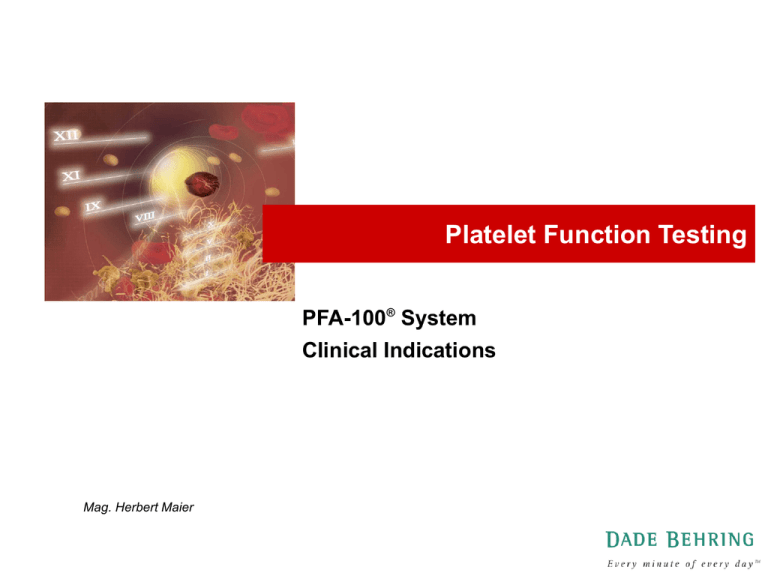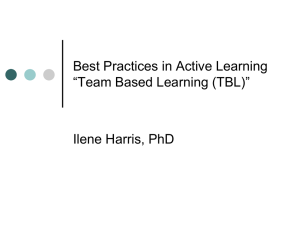Introduction to Platelet Function Analysis with PFA-100®
advertisement

Platelet Function Testing PFA-100® System Clinical Indications Mag. Herbert Maier Overview of the PFA-100® Test System Overview Introduction Overview of the Test System Test Principle Intended Use and Clinical Performance PFA-100® compared to Bleeding Time VWD and DDAVP Acetyl Salicylic Acid (ASA, Aspirin® - Bayer) Use of PFA in: Pre-surgical screening and Bleeding Risk management Risk Stratification of CVD patients Transfusion medicine HM 2 PFA-100® Platelet Function Analyzer Built-In Printer LCD screen Soft keys Trigger solution container Test Cartridge Cassette Carousel HM 3 PFA-100® Test Principle before after p = -40 mBar cup aperture Ø150 µM 800 µl blood Filter + epinephrine or ADP collagen capillary Ø 200 µM flash membrane HM 4 Platelet plug PFA-100® Test Principle PFA-100® In Vivo Haemostasis high shear rate >5000 /s endothelial cell Epinephrine or ADP collagen fibrils membrane with collagen coating von Willebrand Factor von Willebrand Factor erythrocyte fibrinogen platelet platelet FLOW erythrocyte capillary 200µm lumen To: Poujol, Nurden, Paponneau, et al. HM 5 PFA-100® Test Principle - summary Simulates in-vivo conditions; high shear such as present in small arteries (CVD) High shear increases the sensitivity to vWF abnormalities Assesses the effect of anti-platelet agents under physiological conditions* *also recommendation of subcommittee on Biorheology - ISTH 1999 HM 6 Expected Normal Ranges Expected Values 3.8% (129mM) buffered Sodium citrate; 90% Central Interval (sec)**: Col/Epi Col/ADP 85 - 165 71 - 118 ** : data based on testing of 127 samples with normal platelet function in Germany HM 7 ** Dade® PFA-100® System Package Insert PFA-100® Clinical Performance Comparison of the PFA-100® with skin Bleeding Time test 1 Populations: 206 normals 176 abnormals Sensitivity PFA-100® Bleeding Time test PFA-100® Area Under Curve Error 0 0 HM 1 - Specificity 1 8 To : Mammen, Comp, Gosselin, et al.. 0.98 0.01 Bleeding Time test 0.70 0.04 Sensitivity of PFA-100® System for Platelet Dysfunction Sensitivity for Platelet Dysfunction Cases Sensitivity (%) GT BSS SPD HPS ASA 14 2 16 11 127 100% 100% 75% 91% 95% Overall sensitivity for platelet disorders: HM * with Dade® PFA-100® Col/Epi Cartridge 91% (based on meta-analysis of 15 studies) 9 E.J. Favoloro. Haemophilia 2001; 7:170-179 Sensitivity of PFA-100® System for vWD Sensitivity for von Willebrand Disease Type 1 2A 2B 2M 3 Acquired Cases 174* 33 36 12 31 8/8 Sensitivity (%) 88% 100% 92% 100% 100% 100% Overall sensitivity for VWD: HM 10 92% VWD patient management with DDAVP Correction of Primary Hemostasis in vWD patients Fressinaud et al. British Journal of Haematology 1999;106(3):777-783. HM 11 PFA-100® and ASA resistance Cardiac Population Review of the literature on 1,105 patients on ASA frequency of normal Col/Epi result: 23% of 283 ACS patients Poulsen et al; ESC 2003 38% of 129 post-AMI patients Andersen et al., 2003 10% of 325 patients with CVD Gum et al., 2001 27% of 89 patients with CVD, CAD Santos et al; ISTH 2001 42% of 31 pts. with stable angina Crowe et al; ISTH 2001 25% of 105 pts. with CAD von Pape et al; ASH 2000 58% of 43 pts. undergoing PTCA von Pape et al; ASH 2000 45% of 100 pts. with ACS Sambola et al; ISTH 2001 = 25% of low-responders or non-compliants! HM 12 PFA-100® and ASA resistance Stroke Population Review of the literature on 300 patients on ASA frequency of normal Col/Epi result: • 33% of 118 cerebral ischemia patients • 37% of 129 cerebrovascular patients • 23% of 53 cerebrovascular patients Hanswillemenke et al; GTH 2002 Alberts et al., 2004 Grundmann et al., 2003 = 33% of low-responders or non-compliants! HM 13 PFA-100® and ASA resistance Review of the literature on 552 patients with clinical data Patients with AMI had 38% ASA non-responders compared to 18% for non AMI patients Poulsen et al., 2003 The event rates was 36% in the post-AMI group of ASA non-reponders, compared to 24% for the responders Andersen et al., 2003 Patients with recurrent cerebral ischemia attacks had 30% ASA non responders, compared to 15% for patients with stable clinic Hanswillemenke et al; GTH 2002 Symptomatic cerebral ischemia patients had 34% ASA non-responders, compared to 0% for the asymptomatic group Grundmann et al., 2003 HM There is a correlation between ASA nonresponsiveness measured by PFA-100® and clinical events! 14 Conclusion: aspirin non-responders Poor response to aspirin has been found in 1. 2. 3. Acute coronary syndromes, where it predicted deaths Late venous graft occlusion after bypass Recurrent TIA ACS patients with aspirin home therapy could also profit from additional aspirin infusion (Fuchs & Jilma) HM 15 ASA-containing Medication in Germany (1) Acesal Tbl., 500 mg Acetylin Tbl., 500 mg Acetylsalicylsäure Tbl. Michallik, 500 mg Alka-Seltzer Brausetbl., 325 mg Asasantin Tbl., 330 mg Aspirin direkt Kautbl., 500 mg Aspirin protect, 100 und 300 mg Aspro Tbl., 320 mg ASS Bonfal Infarktschutz Tbl., 75 mg ASS dura Tbl., 500 mg ASS 100 Tbl. Lichtenstein ASS Kombi ratiopharm Brausetbl., 300 mg ASS ratiopharm Tbl., 100, 300, 500 mg ASS Stada 100/500 Tbl.-Boxazin plus C Br.-tbl., 500mg Acesal-Calcium, 250 mg Acetylsalicylsäure 500 PB, 500 mg Alacetan N Tbl., 250 mg Antineuralgie Tbl. Scheurich, 250 mg Aspirin Tbl., 500 mg, 300 mg, 100 mg Aspirin plus C Brausetbl., 400 mg Aspisol Amp., 500 mg ASS-AbZ Tbl. ASS 100/500 Hexal Tbl. ASS Kreuz, 500 Tbl. ASS light 100 Azupharma ASS mini Tbl., von CT, 50 mg ASS +C Braustbl. 500 mg ASS opt. Tbl., 500 mg Boxonal Tbl., 210 mg CC-ASS-500 Tbl., 500 mg CC-Cor Tbl., 30 mg Cebion Erkältungsbrausetbl., 50 mg Coffalon Tbl., 200 mg (Calicylamid) CC-forte Tbl., 250 mg Chephapyrin N Tbl., 250 mg Coffetylin Tbl., 450 mg Contradol Pastillen-Dolomo TN Tbl., 250 mg Doppel-Spalt compact Tbl., 500 mg Dolviran N Tbl., 500 mg Dorocoff-ASS plus Tbl., 400 mg *All medications are listed registered trade marks from various companies HM 16 (Koscnielny, personal communication) ASA-containing Medication in Germany (2) Gelonida NA supp. für Ki/Erw., 125 mg/500 mg Godamed 100/500 Tbl., 100 /500 mg Herz ASS ratiopharm 50/100 Tbl., 50 mg/ 100 mg Glutidal Tbl., 400 mg (Salicylamid) Godasal Tbl., 500 mg-HA-Tbl.N., 250 mg Hermes ASS plus Tbl., 400 mg Malinert Tbl., 325 mg Melanbon+C Brausetbl., 500 mg Mentopin Vit. C+ASS Brausetbl., 500 mg Miniasal Tbl., 30 mg Neuranidal Tbl., 300 mg Ortoton Plus Tbl., 400 mg Praecineural Tbl., 350 mg und supp. 500 mg Quadronal ASS comp. Tbl., 460 mg Rio-Josipyrin N Tbl., 250 mg Melabon K Tbl., 250 mg Menostabil-ASS Tbl. Micristin Tbl., 500 mg Neuralgin Tbl., 250 mg Neuranidal Duo Brausetbl., 400 mg Pono-ASS Kaps. Pyracil N Tbl. Ring N Tbl., 300 mg Romigal ASS 500 Tbl., 500 mg Santasal N Tbl., 500 mg Spalt A+P Tbl., 300 mg Spalt ASS Tbl., 600 mg Spalt plus Tbl., 250 mg Temagin ASS 600 Tbl., 600 mg Tempil N Kaps., 250 mg Thomapyrin C Brausetbl., 300 mg Togal Kopfschmerzbrause + Vit.C, 500 mg Temagin PAC Tbl., 250 mg Thomapyrin Tbl., 250 mg Togal Tbl., 250 mg Togal ASS Tbl., 400 mg Werodon-ASS Tbl. *All medications are listed registered trade marks from various companies HM 17 (Koscnielny, personal communication) PFA-100® in Preoperative Screening The Berlin Experience* - Set Up During 2000, 5649 patients, filled in a questionnaire dedicated to bleeding observations • Results pos.resp. pred.value – prolonged bleeding 5.7% 8.2% – high frequency of “blue spots” 5.1% 65.4% – NSAID’s 3.6% 83.9% – Menorrhagia 4,5% • All patients were tested with a panel of screening tests: Platelet Count, APTT, PT, PFA-100 (Col/Epi and Col/ADP) Patients, with a positive bleeding history (11.2%), were tested with two additional tests; BT (Surgicutt®), VWF:Ag. HM 18 * Koscielny J, et al. Clin Appl Thrombosis/Hemostasis 2004; 10(3): 195-204 PFA-100® in Preoperative Screening The Berlin Experience* - Results Negative Bleeding History n=5.021 (88.8%) All Patients n=5.649 Abnormal Screening Tests n=9 (0.2%) APTT Platelet Count Abnormal Screening Tests n=256 (40.8%) PFA-100® (C/Epi) n = 250 (97.7%) PFA-100® (C/ADP) n = 199 (77.7%) ‡ BT n = 188 (73.4%) VWF:Ag n = 39 (15.2%) § APTT n = 24 (9.4%) # PT n = 10 (3.9%) ¶ Platelet Count n = 2 (0.8%) n = 9 (0.2%) * n = 0 (0.0%) † Not detected with PFA-100® (Col/Epi): ‡ 2 patients with hereditary thrombopathy § 2 patients with VWD # 2 patients with VWD ¶ 1 pat. w. dysfibrinogenaemia, 1 w. F VII-deficiency * all 9 patients had lupus inhibitors † 1 patient had pseudothrombocytopenia HM Positive Bleeding History n=628 (11.2%) 19 * Koscielny J, et al. Clin Appl Thrombosis/Hemostasis 2004; 10(3): 195-204 PFA-100® in Preoperative Screening Patients with impaired hemostasisis n=256 Results 2 * Secondary haemostatic disorders; n = 2 (0.8%) Congenital dysfibrinogenaemia n=1 Hereditary F VII deficiency n = 1 Primary haemostatic disorders; n = 187 (73.0%) Acquired thrombocytopathies Von Willebrand disease uremia associated drug induced acetylsalicylic acid diclofenac ibuprofen piroxicam ticlopidine clopidogrel valproic acid ciprofloxacin cefotaxin azlocillin benzylpenicillin VWD:type 1 n = 40 VWF:Ag(%): 38 (27-49) VWD: possible type 1 n = 12 VWF:Ag(%): 57 (50-65) VWD:type 2a n=2 VWF:Ag(%): 55 (35-62) n=7 n = 87 n = 29 n=7 n=5 n = 17 n=2 n=5 n=3 n=2 n=2 n=3 Hereditary thrombocytopathies Glanzmann Thromb. Bernard-Soulier S. Secretion Defects HM Combined haemostatic disorders; n = 67 (26.2%) n=1 n=1 n = 16 20 * Koscielny J, et al. Clin Appl Thrombosis/Hemostasis 2004; 10(3): 195-204 Liver cirrhosis VWD:type 1 n = 13 PFA-100® in Preoperative Screening Conclusions* The vast majority of these patients could not be identified by routine screening for PT, APTT and Platelet Count 250 of these patients (256) are detected with the PFA-100® (Col/Epi) A combination of all tests, without PFA-100® would miss up to 30% of the patients at risk for bleeding! The PFA-100® (Col/Epi) demonstrated a PPV of 81.8% and NPV of 93.4% for impaired hemostasis The PFA-100® system is clearly superior to the bleeding time. HM 21 * Koscielny J, et al. Clin Appl Thrombosis/Hemostasis 2004; 10(3): 195-204 PFA-100® in Preoperative Screening Recommendations* For patients needing a pre-surgical work-up, a test panel without the PFA100® (Col/Epi) is insufficient. Patients with increased risk for bleeding complications can be identified using a standardized questionnaire and a test panel comprised of PFA100® (Col/Epi), VWF-Ag, PT and APTT. The PFA-100® (col/Epi) is important also for assessing the therapeutic efficacy of drugs such as aspirin and desmopressin acetate (DDAVP) HM 22 * Koscielny J, et al. Clin Appl Thrombosis/Hemostasis 2004; 10(3): 195-204 Preoperative management of patients with impaired hemostasis The Berlin Experience* - Results The administration of DDAVP led to a correction of platelet dysfunction in 229 of the 254 patients treated (90.2%). In patients with corrected impaired hemostasis the number of blood transfusions was non-significantly lower (9.4% vs. 12.2%; p = 0.202), than in patients without impaired hemostasis. In a retrospective group of patients with non-corrected impaired hemostasis, the number of blood transfusions was significantly higher (89.3% vs. 11.3%; p < 0.001) than in patients without impaired hemostasis. HM 23 * Koscielny J, et al. Clin Appl Thrombosis/Hemostasis 2004; 10(2): 155-166 Preoperative management of patients with impaired hemostasis Results * Retrospective study n=5102 Elective operations Prospective study n=5649 Non-corrected normals Non-corrected Impaired Non-corrected normals n=4785 n=317 n=5393 transfused n=541 (11,3%) Transfused (%) 100 transfused n=283 (89,3%) Corrected Impaired n=256 transfused n=660 (12,2%) p < 0.001 80 60 p = 0.202 40 20 0 1999 retrospective HM 2000 prospective 24 * Koscielny J, et al. Clin Appl Thrombosis/Hemostasis 2004; 10(2): 155-166 transfused n=24 (9,4%) Platelet Function in Patients with Acute MI* Set-up Patients with acute chest pain or symptoms suggestive of acute coronary syndromes (n=216) were prospectively examined at an emergency unit. Results COL/ADP-CT was significantly shorter in MI patients, than in other patient groups (unstable angina, stable coronary artery disease), or controls. Furthermore, COL/ADP-CT and COL/EPI–CT at presentation were independent predictors of myocardial damage as measured by CK-MB or TnT. Patients with MI whose COL/ADP-CT values fell in the first quartile had 3-fold higher CK-MB and TnT levels than those in the fourth quartile. HM 25 * Frossard M, et al. Circulation. 2004;110:1392-1397 Potential applications for PFA-100 in transfusion medicine Quality control of platelet concentrates – Collection (van der Boehlen et al. 2001, Feuring et al. 2001) – Storage (Beck et al. 2002, Borzini et al. 1999) – Cryo-Preservation (Borzini et al. 1999, 2000) Therapeutic monitoring (e.g. DDAVP) » Eriksson et al. Vox Sang 1996 Peri-operative transfusion management – Platelet concentrates (Raman et al. 2001) HM 26 Conclusion INDICATIONS FOR PFA-100 BLEEDING Screening for VWD and platelet dysfunction Transfusion medicine: donor screening, transfusion efficacy Menorrhagia: screening for platelet defect / VWD Surgery: patients with high risk for platelet dysfunction or vWD THROMBOSIS Detection of aspirin non-responsiveness and platelet hyperactivity HM 27 The End Thank you for your attention! HM 28







